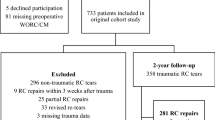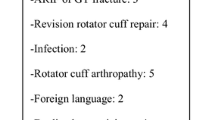Abstract
Purpose
The purpose was to investigate whether surgical repair earlier or later than 3 months after injury may result in similar outcomes and patient satisfaction.
Methods
Seventy-three patients (75 shoulders, 58 males, mean age 59) who had undergone surgical intervention for traumatic rotator cuff tears from 1999 to 2011 were assessed by MRI, clinical examination and Western Ontario Rotator Cuff Index (WORC) as a primary outcome measure and Oxford Shoulder score (OSS), Constant–Murley score (CS) and EQ-5D as secondary. The patients treated less than 3 months after injury (n = 39) were compared with patients treated more than 3 months after injury (n = 36). The average follow-up time was 56 months (range 14–149), and the average time from injury to repair for all patients was 16 weeks (range 3–104). A single senior radiologist performed a blinded evaluation of all the MRIs. Rotator cuff integrity, presence of arthritis, fatty degeneration and muscle atrophy were evaluated.
Results
No differences were found for any of the assessed outcomes (WORC, OSS, CS and EQ-5D) between the two groups. The mean WORC % was 77 % for both groups. Re-tear frequency was 24 %, nine in both groups. Patients with re-tear reported less satisfaction with their outcome.
Conclusions
The surgical treatment of symptomatic traumatic rotator cuff tears repairable later than 3 months after injury yields a good functional outcome, a high level of subjective patient satisfaction, and at the same level for patients receiving earlier treatment. Based on our findings, surgical repair could be encouraged whenever technically possible.
Level of evidence
Retrospective Comparative Study, Level III.



Similar content being viewed by others
References
Bassett RW, Cofield RH (1983) Acute tears of the rotator cuff: the timing of surgical repair. Clin Orthop Relat Res 175:18–24
Baumgarten KM, Gerlach D, Galatz LM, Teefey SA, Middleton WD, Ditsios K, Yamaguchi K (2009) Cigarette smoking increases the risk for rotator cuff tears. Clin Orthop Relat Res 468:1534–1541
Björnsson HC, Norlin R, Johansson K, Adolfsson LE (2011) The influence of age, delay of repair, and tendon involvement in acute rotator cuff tears: structural and clinical outcomes after repair of 42 shoulders. Acta Orthop 82:187–192
Boorman RS, More KD, Hollinshead RM, Wiley JP, Brett K, Mohtadi NG, Nelson AA, Lo IKY, Bryant D (2014) The rotator cuff quality-of-life index predicts the outcome of nonoperative treatment of patients with a chronic rotator cuff tear. J Bone Joint Surg Am 96:1883–1888
Chakravarty K, Webley M (1993) Shoulder joint movement and its relationship to disability in the elderly. J Rheumatol 20:1359–1361
Cofield RH, Parvizi J, Hoffmeyer PJ, Lanzer WL, Ilstrup DM, Rowland CM (2001) Surgical repair of chronic rotator cuff tears. J Bone Joint Surg Am 83:71
Collin PG, Gain S, Nguyen Huu F, Lädermann A (2015) Is rehabilitation effective in massive rotator cuff tears? Orthop Traumatol Surg Res 101:S203–S205
Constant CR, Gerber C, Emery RJH, Søjbjerg JO, Gohlke F, Boileau P (2008) A review of the constant score: modifications and guidelines for its use. J Shoulder Elbow Surg 17:355–361
Constant CR, Murley AH (1987) A clinical method of functional assessment of the shoulder. Clin Orthop Relat Res 214:160–164
Ekeberg OM, Bautz-Holter E, Keller A, Tveitå EK, Juel NG, Brox JI (2010) A questionnaire found disease-specific WORC index is not more responsive than SPADI and OSS in rotator cuff disease. J Clin Epidemiol 63:575–584
Franceschi F, Papalia R, Vasta S, Leonardi F, Maffulli N, Denaro V (2012) Surgical management of irreparable rotator cuff tears. Knee Surg Sports Traumatol Arthrosc 23:494–501
Gartsman GM (1997) Massive, irreparable tears of the rotator cuff. results of operative débridement and subacromial decompression. J Bone Joint Surg Am 79:715–721
Goutallier D, Postel JM, Bernageau J, Lavau L, Voisin MC (1994) Fatty muscle degeneration in cuff ruptures: pre- and postoperative evaluation by CT scan. Clin Orthop Relat Res 304:78–83
Hantes ME, Karidakis GK, Vlychou M, Varitimidis S, Dailiana Z, Malizos KN (2011) A comparison of early versus delayed repair of traumatic rotator cuff tears. Knee Surg Sports Traumatol Arthrosc 19:1766–1770
Hattrup SJ (1995) Rotator cuff repair: relevance of patient age. J Shoulder Elbow Surg 4:95–100
Kirkley A, Alvarez C, Griffin S (2003) The development and evaluation of a disease-specific quality-of-life questionnaire for disorders of the rotator cuff: the western ontario rotator cuff index. Clin J Sport Med 13:84–92
Kirkley A, Griffin S, Dainty K (2003) Scoring systems for the functional assessment of the shoulder. Arthroscopy 19:1109–1120
Kuhn JE, Dunn WR, Sanders R, An Q, Baumgarten KM, Bishop JY, Brophy RH, Carey JL, Holloway BG, Jones GL, Ma CB, Marx RG, McCarty EC, Poddar SK, Smith MV, Spencer EE, Vidal AF, Wolf BR, Wright RW, MOON Shoulder Group (2013) Effectiveness of physical therapy in treating atraumatic full-thickness rotator cuff tears: a multicenter prospective cohort study. J Shoulder Elbow Surg Al(22):1371–1379
Kukkonen J, Joukainen A, Lehtinen J, Mattila KT, Tuominen EKJ, Kauko T, Äärimaa V (2014) Treatment of non-traumatic rotator cuff tears a randomised controlled trial with one-year clinical results. Bone Joint J 96-B:75–81
Lähteenmäki HE, Virolainen P, Hiltunen A, Heikkilä J, Nelimarkka OI (2006) Results of early operative treatment of rotator cuff tears with acute symptoms. J Shoulder Elbow Surg 15:148–153
Moosmayer S, Lund G, Seljom US, Haldorsen B, Svege IC, Hennig T, Pripp AH, Smith H-J (2014) Tendon repair compared with physiotherapy in the treatment of rotator cuff tears. J Bone Joint Surg Am 96:1504–1514
Mukovozov I, Byun S, Farrokhyar F, Wong I (2013) Time to surgery in acute rotator cuff tear. Bone Joint Res 2:122–128
Ogilvie-Harris DJ, Demaziere A (1993) Arthroscopic debridement versus open repair for rotator cuff tears. A prospective cohort study. J Bone Joint Surg Br 75-B:416–420
Oh LS, Wolf BR, Hall MP, Levy BA, Marx RG (2007) Indications for rotator cuff repair. Clin Orthop Relat Res 455:52–63
Petersen SA, Murphy TP (2011) The timing of rotator cuff repair for the restoration of function. J Shoulder Elbow Surg 20:62–68
Sher JS, Uribe JW, Posada A, Murphy BJ, Zlatkin MB (1995) Abnormal findings on magnetic resonance images of asymptomatic shoulders. J Bone Joint Surg 77:10–15
Sørensen AKB, Bak K, Krarup AL, Thune CH, Nygaard M, Jørgensen U, Sloth C, Torp-Pedersen S (2007) Acute rotator cuff tear: Do we miss the early diagnosis? a prospective study showing a high incidence of rotator cuff tears after shoulder trauma. J Shoulder Elbow Surg 16:174–180
Swedish National Musculoskeletal Competence Centre (2006) National Indications for shoulder surgery
Tempelhof S, Rupp S, Seil R (1999) Age-related prevalence of rotator cuff tears in asymptomatic shoulders. J Shoulder Elbow Surg 8:296–299
Thomazeau H, Rolland Y, Lucas C, Duval JM, Langlais F (1996) Atrophy of the supraspinatus belly. Assessment by MRI in 55 patients with rotator cuff pathology. Acta Orthop Scand 67:264–268
Wolfgang GL (1974) Surgical repair of tears of the rotator cuff of the shoulder. J Bone Joint Surg 56:14–26
Yamaguchi K, Tetro AM, Blam O, Evanoff BA, Teefey SA, Middleton WD (2001) Natural history of asymptomatic rotator cuff tears: a longitudinal analysis of asymptomatic tears detected sonographically. J Shoulder Elbow Surg 10:199–203
Zingg PO, Jost B, Sukthankar A, Buhler M, Pfirrmann CWA, Gerber C (2007) Clinical and structural outcomes of nonoperative management of massive rotator cuff tears. J Bone Joint Surg 89:1928–1934
Acknowledgments
Great thanks are due to the Aleris Department of Radiology and the Department of Orthopaedics at Danderyds Hospital for their generous sponsoring of the MRI investigation for this study.
Authors’ contributions
SZ study design, data collection, data analysis and writing the manuscript; AVH assessment of all the performed MRIs, review of the manuscript; AS review of the manuscript; EH review of the manuscript; BS study design, data analysis and review of the manuscript. All the authors read and approved the final manuscript.
Author information
Authors and Affiliations
Corresponding author
Ethics declarations
Conflict of interest
We have no competing interests to declare.
Rights and permissions
About this article
Cite this article
Zhaeentan, S., Von Heijne, A., Stark, A. et al. Similar results comparing early and late surgery in open repair of traumatic rotator cuff tears. Knee Surg Sports Traumatol Arthrosc 24, 3899–3906 (2016). https://doi.org/10.1007/s00167-015-3840-0
Received:
Accepted:
Published:
Issue Date:
DOI: https://doi.org/10.1007/s00167-015-3840-0




